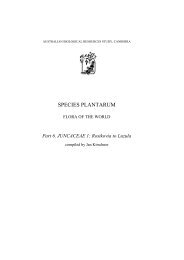Introduction - Species Plantarum Programme
Introduction - Species Plantarum Programme
Introduction - Species Plantarum Programme
You also want an ePaper? Increase the reach of your titles
YUMPU automatically turns print PDFs into web optimized ePapers that Google loves.
1: Branchlets not spinescent<br />
20<br />
SPECIES PLANTARUM — FLORA OF THE WORLD (1999)<br />
5 Plant glandular-pubescent, rarely almost glabrous<br />
6 Leaves 10–30 mm wide 1. A. viscosa<br />
6: Leaves 0.5–10 mm wide<br />
7 Corolla 9–16 mm long, the lobes 4–9 mm long 2. A. fasciculata<br />
7: Corolla 15–28 mm long, the lobes 10–20 mm long<br />
8 Leaves, pedicels and calyces pubescent with conspicuous<br />
glandular hairs; corolla-tube narrowly funnel-shaped 3. A. angustifolia<br />
8: Leaves, pedicels and calyces glabrous or sparsely pubescent with<br />
inconspicuous hairs; corolla-tube inflated, slightly constricted at<br />
apex 9. A. gracilis<br />
5: Plant glabrous, rarely pubescent, the branches sometimes with prickles<br />
9 Leaves 1–2 mm wide, few at flowering; flowers in small groups 9. A. gracilis<br />
9: Leaves 4–35 mm wide; branches leafy; inflorescence raceme- or<br />
panicle-like<br />
10 Plant much-branched from base; inflorescence a leafy raceme;<br />
corolla-tube not more than one-third of corolla length, the lobes<br />
narrow 4. A. littorea<br />
10: Plant with 1 or 2 main stems; inflorescence a pyramidal panicle<br />
leafless except at base; corolla-tube one-third to one-half of corolla<br />
length, the lobes broad 5. A. ilicifolia<br />
Extract from Fl. Australia 29: 6–7 (1982)<br />
The species are numbered in the same order as they appear in the text. As with genera, this<br />
order is determined by the writer and, if possible, should bring related species close together.<br />
Data used in the key should also be included if possible in the specific descriptions. In large<br />
genera it will not be possible to include information from every lead in the key in the<br />
descriptions, because of the word limit. In these cases it is useful to ensure that characters<br />
from the last few leads are included, as these frequently contain the more diagnostic<br />
characters.<br />
Note that the key to species does not include infraspecific taxa. These are keyed out after the<br />
description of the species concerned.<br />
TREATMENT OF SPECIES<br />
The number, name and bibliographic reference form a heading for each species. There is no<br />
full stop at the end of this heading.<br />
For guidelines on abbreviations of authors, books and journals in bibliographic references,<br />
the works cited earlier (p. 13) should be consulted.<br />
Type information<br />
Following the heading, information is given about the Type, starting on a new line. This<br />
begins with information on the Type specimen unless there is a basionym, in which case this<br />
precedes the specimen information. Synonyms are grouped homotypically, i.e. all names<br />
based on a single Type occur together as a discrete paragraph. These paragraphs are arranged












